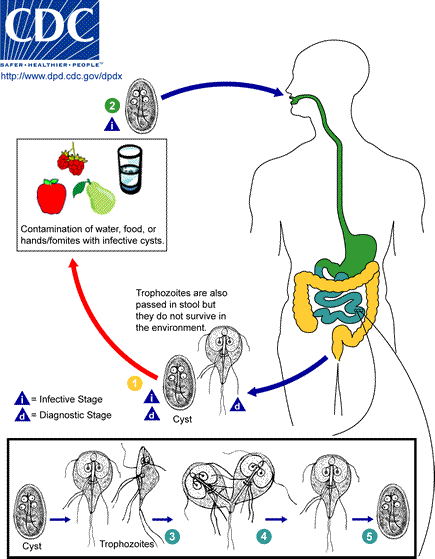|
Giardia
''Giardia'' ( or ) is a genus of anaerobic flagellated protozoan parasite Parasitism is a close relationship between species, where one organism, the parasite, lives on or inside another organism, the host, causing it some harm, and is adapted structurally to this way of life. The entomologist E. O. Wilson h ...s of the phylum Metamonada that colonise and reproduce in the small intestines of several vertebrates, causing the disease giardiasis. Their life cycle alternates between a swimming trophozoite and an infective, resistant Microbial cyst, cyst. ''Giardia'' were first described by the Netherlands, Dutch microscopist Antonie van Leeuwenhoek in 1681. The genus is named after French zoologist Alfred Mathieu Giard. Characteristics Like other diplomonads, ''Giardia'' have two cell nucleus, nuclei, each with four associated Flagellum, flagella, and were thought to lack both mitochondrion, mitochondria and Golgi apparatus, Golgi apparatuses. However, they are now kn ... [...More Info...] [...Related Items...] OR: [Wikipedia] [Google] [Baidu] |
Giardiasis
Giardiasis is a parasitic disease caused by ''Giardia duodenalis'' (also known as ''G. lamblia'' and ''G. intestinalis''). Infected individuals who experience symptoms (about 10% have no symptoms) may have diarrhea, abdominal pain, and weight loss. Less common symptoms include vomiting and blood in the stool. Symptoms usually begin 1 to 3 weeks after exposure and, without treatment, may last two to six weeks or longer. Giardiasis usually spreads when ''Giardia duodenalis'' cysts within feces contaminate food or water that is later consumed orally. The disease can also spread between people and through other animals. Cysts may survive for nearly three months in cold water. Giardiasis is diagnosed via stool tests. Prevention may be improved through proper hygiene practices. Asymptomatic cases often do not need treatment. When symptoms are present, treatment is typically provided with either tinidazole or metronidazole. Infection may cause a person to become lactose intolerant, so ... [...More Info...] [...Related Items...] OR: [Wikipedia] [Google] [Baidu] |
Giardia Lamblia
''Giardia duodenalis'', also known as ''Giardia intestinalis'' and ''Giardia lamblia'', is a flagellated parasitic microorganism of the genus '' Giardia'' that colonizes the small intestine, causing a diarrheal condition known as giardiasis. The parasite attaches to the epithelium by a ventral adhesive disc or sucker, and reproduces via binary fission. Giardiasis does not spread via the bloodstream, nor does it spread to other parts of the gastrointestinal tract, but remains confined to the lumen of the small intestine. Giardia has an outer membrane that makes it possible to retain life, even when outside of the host body, and which can make it tolerant to chlorine disinfection. ''Giardia'' trophozoites absorb their nutrients from the lumen, and are anaerobes. If the organism is split and stained, its characteristic pattern resembles the familiar "smiley face" symbol. Chief pathways of human infection include ingestion of untreated drinking water (which is the mos ... [...More Info...] [...Related Items...] OR: [Wikipedia] [Google] [Baidu] |
Giardia Agilis
''Giardia'' ( or ) is a genus of anaerobic flagellated protozoan parasites of the phylum Metamonada that colonise and reproduce in the small intestines of several vertebrates, causing the disease giardiasis. Their life cycle alternates between a swimming trophozoite and an infective, resistant cyst. ''Giardia'' were first described by the Dutch microscopist Antonie van Leeuwenhoek in 1681. The genus is named after French zoologist Alfred Mathieu Giard. Characteristics Like other diplomonads, ''Giardia'' have two nuclei, each with four associated flagella, and were thought to lack both mitochondria and Golgi apparatuses. However, they are now known to possess a complex endomembrane system as well as mitochondrial remnants, called mitosomes, through mitochondrial reduction. The mitosomes are not used in ATP synthesis the way mitochondria are, but are involved in the maturation of iron-sulfur proteins. The synapomorphies of genus ''Giardia'' include cells with duplicate ... [...More Info...] [...Related Items...] OR: [Wikipedia] [Google] [Baidu] |
Giardia Ardeae
''Giardia'' ( or ) is a genus of anaerobic flagellated protozoan parasites of the phylum Metamonada that colonise and reproduce in the small intestines of several vertebrates, causing the disease giardiasis. Their life cycle alternates between a swimming trophozoite and an infective, resistant cyst. ''Giardia'' were first described by the Dutch microscopist Antonie van Leeuwenhoek in 1681. The genus is named after French zoologist Alfred Mathieu Giard. Characteristics Like other diplomonads, ''Giardia'' have two nuclei, each with four associated flagella, and were thought to lack both mitochondria and Golgi apparatuses. However, they are now known to possess a complex endomembrane system as well as mitochondrial remnants, called mitosomes, through mitochondrial reduction. The mitosomes are not used in ATP synthesis the way mitochondria are, but are involved in the maturation of iron-sulfur proteins. The synapomorphies of genus ''Giardia'' include cells with duplica ... [...More Info...] [...Related Items...] OR: [Wikipedia] [Google] [Baidu] |

